|
|
|
Sort Order |
|
|
|
Items / Page
|
|
|
|
|
|
|
| Srl | Item |
| 1 |
ID:
155668
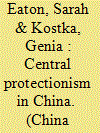

|
|
|
|
|
| Summary/Abstract |
This article examines the so-called “central State Owned Enterprise (SOE) problem” in China's environmental governance system, namely central SOEs' defiance of environmental regulation. We present evidence showing that, in the last decade, central SOEs have been the source of a large number of serious pollution incidents and have often failed to comply with environmental guidelines and regulations. Central SOEs in the electricity generation and oil and gas industries are particularly culpable, with six firms alone accounting for 62 per cent of all 2,370 reported violations (2004–2016). We argue that a combination of “central protectionism” of state-owned national champions and insufficient regulatory capacity in the environmental bureaucracy have provided state firms under central management with both incentives and opportunities to shirk on environmental regulations. Yet, while the institutions of central protectionism are deeply rooted, countervailing forces within the complex Chinese state are also gaining momentum. In spite of the considerable regulatory challenges, officials in the environment bureaucracy display increasing resolve and ingenuity in trying to strengthen their enforcement capacity.
|
|
|
|
|
|
|
|
|
|
|
|
|
|
|
|
| 2 |
ID:
155664


|
|
|
|
|
| Summary/Abstract |
This article analyses centralizing trends that may be able to reduce the negative influence of local protectionism on environmental law enforcement in China. The article finds that as centralizing trends unfolded, enforcement over time has become stricter and more frequent, however with only minor effects in reducing pollution. Moreover it finds a situation of uneven enforcement with richer and more urbanized areas having much stronger and more frequent enforcement than inland areas. Centralizing trends may thus have spurred stronger enforcement, but concurrently allowed for an uneven enforcement. At the same time, the article finds a continued local influence, keeping enforcement too weak to have much effect in reducing pollution and allowing for local interests to shape enforcement into unequal outcomes.
|
|
|
|
|
|
|
|
|
|
|
|
|
|
|
|
| 3 |
ID:
155663
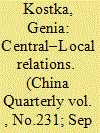

|
|
|
|
|
| Summary/Abstract |
Recent literature on environmental governance in China frequently ascribes blame for China's environmental problems to sub-national governments' lax environmental enforcement. Such research implicitly assumes that more central control would lead to better results but, as yet, the role of the centre in environmental governance remains underresearched. In the context of the current phase of recentralization, this article studies central and local interests, capacities and interactions across policy issues and government agencies. By “bringing the centre back” into the study of central–local relations in China, we examine both where such recentralization has in fact occurred and whether such recentralization efforts have improved environmental outcomes. We argue that centralization does not improve outcomes in every case. Further, central and local levels of governance are not as different as they might seem. Indeed, there are significant areas of overlapping interests and similar patterns of behaviour, both positive (enforcement) and negative (shirking), between central and local administrations. The results draw an empirically and theoretically rich picture of central–local relations that highlights the innate complexity of China's environmental governance patterns during the current phase of recentralization.
|
|
|
|
|
|
|
|
|
|
|
|
|
|
|
|
| 4 |
ID:
155667
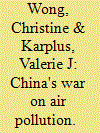

|
|
|
|
|
| Summary/Abstract |
Unprecedented and highly visible degraded air quality in China's urban centres has prompted a step change in central government control efforts in recent years. This “War on Air Pollution” has included a mixture of administrative controls, regulatory clampdowns, economic incentives and public education campaigns. A critical constraint on how policies are designed and implemented is the central government's capacity to access accurate cost information, and monitor, evaluate and enforce the policies at subordinate levels of government. We examine in detail the directives and arrangements that underpin China's “War on Air Pollution” at the provincial level, taking Hebei province as a case study. Located upwind of Beijing, Hebei's heavy industries have been a particular focus of the environmental policies. The current approach, which requires highly specific and costly local actions, yet allocates funds centrally, suffers from misaligned incentives and does not address longstanding weaknesses in local policy monitoring, evaluation and enforcement.
|
|
|
|
|
|
|
|
|
|
|
|
|
|
|
|
| 5 |
ID:
155672
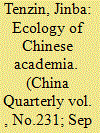

|
|
|
|
|
| Summary/Abstract |
While Chinese academic excellence is gaining increasing international recognition, plagiarism, corruption, nepotism and other negative practices are reportedly rampant in academia in China. Many point the finger at fundamental flaws within the tizhi, the highly structured Chinese socio-political system. I propose re-examining Chinese academia and its practices by applying and expanding Pierre Bourdieu's notion of field as this framework helps to identify the predicament of the “deep water” in which Chinese scholars and institutes find themselves. The four fields I outline – ideological, quasi-official, fame–profit and guanxi fields – spotlight academic practices with “Chinese characteristics.” I elaborate on my own experiences and reflections as both an insider and outsider to these practices, a position which I refer to as a third-eye perspective. I argue that despite the constraints of the “deep water,” the field-oriented angle of investigation reveals that the depths and types of “deep water” vary from one institute to another and also that the internally generated ongoing initiatives promise a step-by-step transformation in Chinese academia. To provoke further thought, I contend that the Chinese case is both a non-exception and alternative to the Western (and other) practices. In so doing, I call for a balanced perspective to re-examine Chinese academic ecology.
|
|
|
|
|
|
|
|
|
|
|
|
|
|
|
|
| 6 |
ID:
155669


|
|
|
|
|
| Summary/Abstract |
This article argues that manufacturing policies of Chinese local governments have provided an important corrective to some of the weaknesses inherent in the central government's indigenous innovation framework, most importantly its inattention to the importance of advanced manufacturing capabilities for innovation. Based on an original dataset of over one hundred executive interviews conducted with 43 Chinese wind and solar firms, I identify both central government R&D funding and continued local government support for manufacturing as critical factors in enabling innovation among China's renewable energy firms. In particular, this article shows that firms have utilized a combination of both central and local government policies to establish unique engineering capabilities required for innovation in commercialization and scale-up to mass production. The findings suggest that continued local government support for the manufacturing economy has not undermined central government innovation policies, but has (1) broadened the range of resources available to entrepreneurial firms and (2) enabled new options for industrial upgrading that are outside the conceptualization of innovation underlying the central government's indigenous innovation framework.
|
|
|
|
|
|
|
|
|
|
|
|
|
|
|
|
| 7 |
ID:
155671
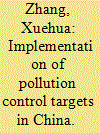

|
|
|
|
|
| Summary/Abstract |
The scholarly work on China's environmental regulations in the context of “central–local” relations is dominated by the preference for a centralized approach. This article examines a centrally imposed and executed verification programme of locally reported pollution data, a rare and sustained central effort to enforce an environmental policy, namely the national pollution reduction target system. The programme was established in 2007 to curtail perceived widespread data falsification and to enhance the quality of emission data, the basis for assessing local compliance with targets. Based on an analysis of official documents and interviews with environmental officials and industry representatives, this article found that the verification programme appears to have reduced the overreporting problem with emission data, enhanced local monitoring and enforcement capacity, and to a certain degree deterred violations due to the increased frequency of national and local inspections. Nevertheless, significant challenges remain. Verification is highly resource intensive, it has involved little external oversight and public participation, the central authority has exerted significant yet unchecked discretionary powers, and poor data quality has remained an issue. Over time, the verification programme appears to have turned into essentially a “numbers game.” All those challenges indicate that a centralized enforcement approach is arguably ineffective in addressing China's long-standing problem of weak environmental policy implementation. This study also sheds lights on the classical “principal-agent” theory in the study of public bureaucracy. Not only does the principal distrust the agent, which is the main concern of the theory, but the agent also distrusts the principal.
|
|
|
|
|
|
|
|
|
|
|
|
|
|
|
|
| 8 |
ID:
155670
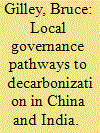

|
|
|
|
|
| Summary/Abstract |
Reducing greenhouse gas emissions in the world's two largest countries requires feasible governance pathways that integrate politics, policy and administration. Using examples of successful mitigation at the local level in China (Guangzhou) and India (Gujarat), this article identifies integrated governance solutions that work in both cases through different types of linkages. In China, it is mainly intra-governmental linkages, while in India it is mainly state–society linkages. In neither case do international negotiations concerning emissions targets have significant effects, while national frameworks have only marginal effects. Approaching the problem in this comparative manner helps to clarify how greenhouse gas governance operates in each country, the lessons for central–local environmental relations, and the implications for international assistance.
|
|
|
|
|
|
|
|
|
|
|
|
|
|
|
|
| 9 |
ID:
155673


|
|
|
|
|
| Summary/Abstract |
In a recent article published in this journal, Yaojiang Shi and John Kennedy suggest that China's missing girls problem is much more a statistical artefact than previously known. According to their analysis, unreported female births, or hidden girls, account for 73 per cent of the 15 million missing girls from the 1990–2010 birth cohorts in the 2010 census. Their conclusion is based in part on their fieldwork, but the numerical estimate is grounded on their understanding and analyses of Chinese census data. While the insights from their fieldwork – that China's political system leaves ample room for data manipulation and delayed registration – cannot be faulted, Shi and Kennedy's analyses of Chinese census data are questionable and their conclusion is in contradiction with the “missing girls” shown in other data sources. In this short note, I present three lines of evidence to challenge Shi and Kennedy's conclusion: one from the censuses, one from official education statistics, and one from survey data. For the sake of clarity, I use two terms to describe missing girls: nominal missing – the number of missing girls as revealed by population statistics, and truly missing – the number of missing girls excluding those hidden (unreported) girls. My conclusion backs the conventional wisdom about the missing girls phenomenon in China: the elevated sex ratios in Chinese population, or “missing girls,” is not a statistical artefact, but a real social challenge that China has to face for now and for the foreseeable future.
|
|
|
|
|
|
|
|
|
|
|
|
|
|
|
|
| 10 |
ID:
155674


|
|
|
|
|
| Summary/Abstract |
We thank Yong Cai for his comments and insights regarding our piece on the “missing girls.” We also recognize and appreciate his expertise in the field of population studies. In short, we agree that we have overestimated the number of nominally missing girls and that the number of hidden or recovered girls may be closer to 10 million or half of the truly missing girls rather than 15 million. Of course, the number of truly missing girls is inconclusive due to the lack of direct measures and the reliance on proxy measures such as previous census data, surveys and state education data. Given the absence of direct measures for the truly missing, scholars also rely on assumptions of villager behaviour and local policy implementation, such as the continued prevalence of son preference as well as the implementation of birth control measures across rural China. Our aim for the “missing girls” article is not to solely challenge the numbers (because we realize the margin of error is in the millions), but we want to challenge the social and political assumptions behind the truly missing. Therefore, we believe the debate over the general estimates of the truly missing is real and should continue.
|
|
|
|
|
|
|
|
|
|
|
|
|
|
|
|
| 11 |
ID:
155665


|
|
|
|
|
| Summary/Abstract |
Based on findings from three years of site-intensive fieldwork at the local level, this article presents evidence to suggest that binary governance frameworks like centre–local relations are insufficient to understand certain local regulatory outcomes in contemporary China. I seek to specify a distinct type of local governance that has been emerging in recent years, which blurs existing binary concepts. It can be distinguished along two main dimensions: ostensible structure and modalities of governance. Two cases are analysed to illustrate the ways in which it impacts local regulatory outcomes. The analyses point to the need for expanding our portfolio of approaches to understanding local governance in contemporary China.
|
|
|
|
|
|
|
|
|
|
|
|
|
|
|
|
| 12 |
ID:
155666
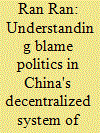

|
|
|
|
|
| Summary/Abstract |
Decentralized environmental governance theory suggests that decentralization can produce better environmental performance mainly because lower-level governments are closer to the people and environmental issues and are considered more legitimate than the national government. However, China's decentralized system of environmental governance has been often regarded as a key factor in creating pollution problems rather than in solving them. To explain this puzzle, this article, using Blame Avoidance Behaviour in government theory as a theoretical framework, examines how blame avoidance behaviour shapes China's decentralized system of environmental governance from three perspectives: first, actors and the chain of blame shaped by the hierarchical power structure among environmental policymakers and implementers; second, the strategies of discursive domination and decentralization for blaming environmental problems on local officials; and lastly, the contextual factor of “hierarchical governmental trust.” Drawing on documentary discursive analysis and extensive fieldwork, this article suggests that the dysfunction of China's decentralized environmental governance structure may in fact be an outcome of a blame-shifting game between central and local governments.
|
|
|
|
|
|
|
|
|
|
|
|
|
|
|
|
|
|
|
|
|